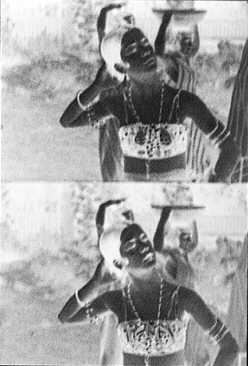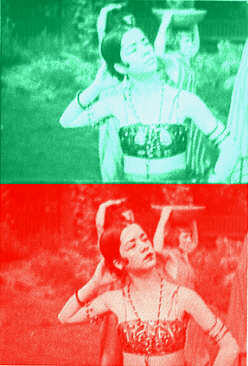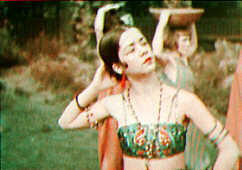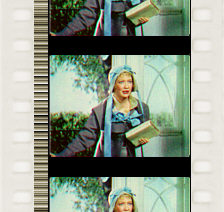 Colour in EARLY CINEMA
Colour in EARLY CINEMAColour as signifier of fantasy, or as metaphor or as sensual intensity or as superadded feature or as greater attraction or as spectacular effect....
EXCELLENT RESOURCE on this subject at following link
http://www.widescreenmuseum.com/oldcolor/oldcolor.htm
Hand Tinted Films
Hand Colored Films
The earliest methods included hand
painting individual frames, tinting the film stock, toning the black and
white emulsion, and combinations of any of these. The results were
frequently quite striking but not particularly realistic.
Natural Color Films - Additive Color
The term natural color
was used for films that more or less recorded their color from the subject
being photographed, rather than having color arbitrarily added after
prints were made. "Additive" means that the color elements are separate on
the film but are overlapped and combined on the screen.
Natural Color Films - Subtractive Color
This type of film
has complementary color dyes in its emulsion. The dye color subtracts its
complementary color as light passes through it, allowing the correct color
records to be projected. While more complex, subtractive color transmits a
far greater amount of light than additive systems.
Technicolour
2-Color Multicolor System
Cinecolor
Color Systems
Two-Color Subtractive Color System
Three-Color Motion Picture Systems
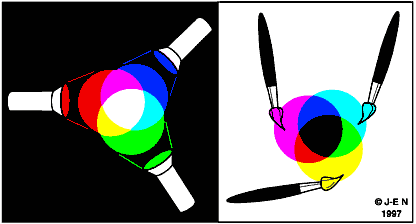 additive and subtractive color palette |
Hand Tinted Films
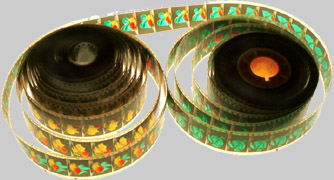 The
language of Color in Early Silent Film
The
language of Color in Early Silent Film
Many Early Films offered color versions - that is hand tinted versions.
Example Méliés Journey to the Moon, DW Griffins Intolerance.
One
surviving early edison exhibition color film - dancer with hand tinted
skirt. Use of colour is spectacular ...convey effects of colored
lights

Download Movie Clip of this dancer clip at
http://www.edisonart.com/welcome.htm
Filmed in 1884 and 1897, these early experimental films show a dancer performing in Edison's "Black Maria" studio in New Jersey. This film is unique in that each frame of the original nitrate based stock has been individually hand coloured - faithfully recording the artistic innovation and technical achievement of the time.
Hand Colored Films 1900s to 1930s
Colour as an attraction in itself..
Pathé Color
This was a labour intensive process. Dated from
1905. Using a combination of techniques such as cutting out stencils in
the film and creating a stencil film for each color applied. This is how
colors were added to every frame of the black and white base print.
Generally, a maximum of six different colors would be added. Became quite
sophisticated
Hand coloring evolved to a fairly high level of sophistication, as can be seen in this frame from The Last Days of Pompeii produced in Italy in 1926.
ADDITIVE SYSTEM
Two Colour Systems
Kinemacolor
Urban and Smith in England in July, 1906
 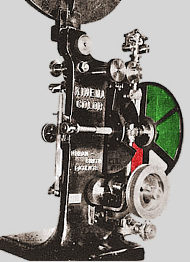 Kinemacolor camera and projector |
The Kinemacolor camera exposed black and white film through alternating red and green filters. The camera speed was 32 frames per second to achieve the normal silent projection speed of 16 color images per second.
Like all sequential color processes, Kinemacolor suffered from color fringing when objects moved, since the two color records were not recorded at the same time. In projection, a filter wheel, similar to that in the camera, added the red and green tints to the successive frames.
Other early additive processes
The Gaumont Chronochrome process Link
The
Horst process Link
Stained
frame printing link
SUBTRACTIVE SYSTEM
Two Colour Kodachrome
With subtractive color system, Color films could be handled exactly the
same way that black & white films could.
Like all other processes
at the time, it recorded its color records on separate frames, using a
camera carrying two negatives. These two negatives were printed on either
side of a single 35mm film which had an emulsion on both sides. The film
was then chemically treated to create a blue/green image on one side and a
red/orange image on the other. Color accuracy, like any two color system,
was compromised, but the results were pleasant. If the proper care was
taken in photography, a fairly broad color spectrum could be presented on
the screen.
Technicolor
System 1 Technicolor System 1 - Additive Color 1917-1922
The company's first color process was a two color additive system similar to Kinemacolor but with two major differences. The Technicolor camera recorded the red and blue-green images simultaneously through a single lens using a beam splitter and color filters to record the images stacked one on top of the other. No rotating color wheel was involved in either the camera or projector. The print was a conventional black and white record that ran through a special projector with two apertures and lenses with color filters adding the tint.
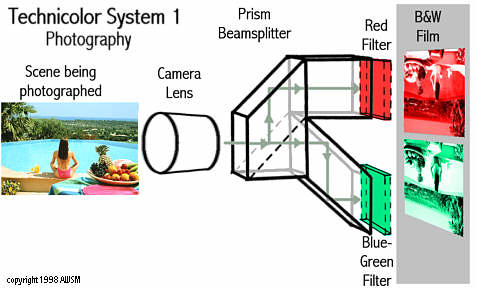 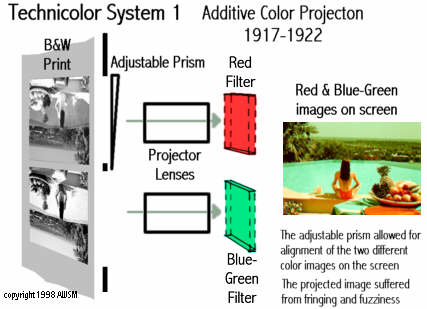 |
System 2 Subtractive Two-Color Cemented Print 1922-1927
Subtractive systems, however, carry the color information in the image itself, with no need for inefficient filters and the registration is as good as the maker can put it on the film in the first place. Subtractive projection also has the ability to reproduce colors a bit more accurately. ..The camera negative carries both the red and blue-green records of the original scene. The blue-green record is upside down in relationship with the red record. Two separate prints are made on half thickness matrix films. The red matrix and blue-green matrix are also printed as mirror images because they will be placed back to back after application of the color dyes. The matrix films were very much like a conventional black and white film, containing the usual silver halides that are light sensitive and also a special gelatin layer. When the film is developed and the silver is removed, the gelatin remains as a "contour map" of the image. In System 2, the matrices were developed and then floated on a dye bath of a color complimentary to the original color record.
The cemented two-color process was used in about two dozen films, mostly in key sequences of otherwise monochrome films. Some of the best known films to utilize the process were The Big Parade (1925), The Merry Widow (1925), The Phantom of the Opera (1925), and Ben-Hur, (1926).
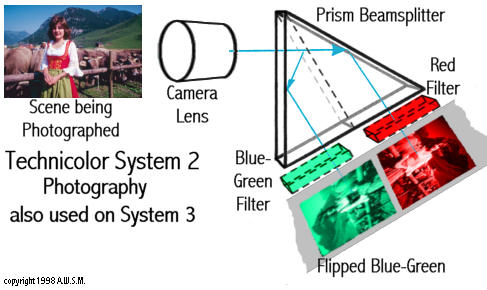 |
Example Ben Hur 1926
Metro-Goldwyn-Mayer's 1926 version of
Ben-Hur included brief Technicolor sequences
 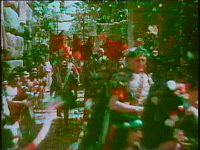 |
System 3 Subtractive Two-Color Dye Transfer Prints 1927-1933
System 3 inherited most of the technology from system 2, but much of it was used in a far different way. The camera was the same, but instead of producing a duplicate negative that generated the matrices that would be dyed and cemented, the matrices were optically generated from the camera negative and were used to make other prints.
System 4 GLORIOUS TECHNICOLOR 1932-1955
the film going audience became underwhelmed with color
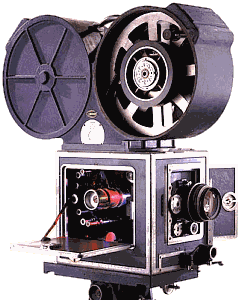 In 1931 Kalmus put the company on the course to develop a
three strip camera and to refine the dye transfer printing that had been
introduced in 1927. In 1932 the first camera was completed, and it was
expensive,
In 1931 Kalmus put the company on the course to develop a
three strip camera and to refine the dye transfer printing that had been
introduced in 1927. In 1932 the first camera was completed, and it was
expensive,
DETAILs on how the camera worked with a detailed diagram of the prism and film advance assembly link
The production of prints began with a "blank" receiver film, which was a black and white stock coated with chemicals called "dye mordants". The function of a mordant is to attract and hold color dyes so that they do not spread or bleed during the high pressure dye application. The "blank" had the soundtrack, black frame lines, and a 50% density copy of the green component exposed to it
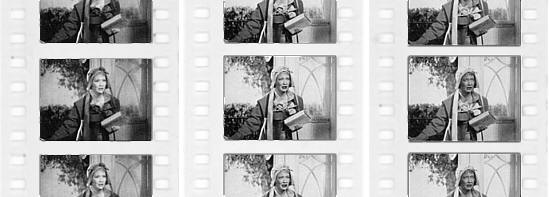 The three printing matrices begin life looking like
conventional black and white films with slightly odd tones. The negatives
are printed to the matrix stock and then the silver image is washed from
the resulting print. This leaves a gelatin "topographical map" impression
of the color content in each matrix. The gelatin is transparent and the
image is nearly invisible.
The three printing matrices begin life looking like
conventional black and white films with slightly odd tones. The negatives
are printed to the matrix stock and then the silver image is washed from
the resulting print. This leaves a gelatin "topographical map" impression
of the color content in each matrix. The gelatin is transparent and the
image is nearly invisible.
 Each matrix is coated with a complimentary color dye, the
red matrix using cyan, the green using magenta, and the blue using yellow.
One at a time the matrices are brought into contact, under high pressure,
with the prepared receiver film and the dye is transferred to the
receiver. With each successive step the color image takes form on the
final print.
Each matrix is coated with a complimentary color dye, the
red matrix using cyan, the green using magenta, and the blue using yellow.
One at a time the matrices are brought into contact, under high pressure,
with the prepared receiver film and the dye is transferred to the
receiver. With each successive step the color image takes form on the
final print.
Walt Disney Used Three Strip Camera
Walt Disney Flowers and Trees 1932 the first commercial film to use the 3-color dye transfer system. He made the popular Three Little Pigs 1932 with the same system
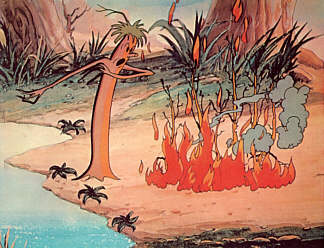
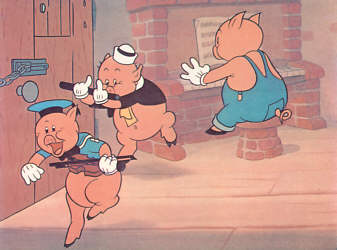
Successive Exposure Photgraphy
While successive photography of movie frames posed problems for live action films, it is an ideal system for use in single frame animation. The camera includes a filter wheel in front of the lens. Each frame gets three exposures, resulting in blue, red, and green color elements recorded in sequence ..In the Technicolor laboratory the processed negative is step printed to three individual matrix films, one each for the blue, red, and green color records. ..After processing, all silver is removed from the matrix films, leaving only a gelatin relief map of the original image. ..The next step in producing a print is the application of color complimentary dyes to the matrix films. The blue record receives a yellow dye, the red a cyan dye, and the green a magenta dye. Printing of the dyed matrices is done on a special "blank" printing film. The blank is essentially a black and white film with special chemicals called "mordants" applied that control the absorption of the dyes. Before printing of the color dyes, the film sound track is duplicated onto the film and black frame lines are exposed onto the stock. From 1932 up until about 1945, the blank also received a 50% black and white duplicate of the green record. This increased apparent sharpness of the image and improved contrast. The dyed matrices are brought into contact with the printing blank under pressure and the blank absorbs the dye. The yellow, cyan, and magenta dyes are transferred one at a time.
Becky Sharp by Pioneer in 1935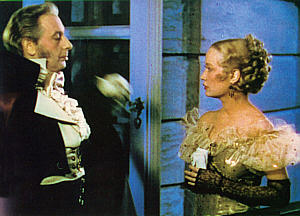
Three strip full color Technicolor® in 1934 Example Becky Sharpe 1935
![]() Clip
available at http://www.sabucat.com/
Clip
available at http://www.sabucat.com/
Other Films with technicolour
The Garden of Allah 1936 starring
Marlene Dietrich, Charles Boyer, and Basil Rathbone.
The Adventures of
Robin Hood, from Warner Bros. in 1938
The Wizard of Oz MGM's 1939
articles on subject
THE TECHNICOLOR PROCESS OF THREE-COLOR
CINEMATOGRAPHY 1935 J.A. Ball link
Technicolor
Adventures in Cinemaland 1938 Herbert Kalmus link
Technicolor
Cinematography 1942 Winton Hoch link
2-Color Multicolor System
- very early colour, precursor to cinecolor, marx brothers in color
Right Click and Play to Play Flash Clip Version. Source
This is a single frame from a tiny treasure unearthed by Sabucat Productions. A 15 second clip from a rehearsal of Animal Crackers, (1930), in a test of the Multicolor system was recently discovered. Multicolor was the predecessor to two-color Cinecolor. The clip is silent, but it provides the only known footage of the brothers in color. Seen in costume are Groucho, (left), Chico (behind Groucho at his right), and Harpo, in a robe and without his wig, tormenting Margaret DuMont. The clip was included in Turner Classic Movies' production of Glorious Technicolor. The condition of this old piece of nitrate film is remarkable, as is the color rendition, and Sabucat's transfer. Bleep from
![]() Color footage of "Animal Crackers", as seen on TCM's
documentary "Glorious Technicolor" Link to various web clip formats
available at http://www.sabucat.com/
go to samples section. This footage was shot in 1930 at Astoria Studios in
(probably) 2-color Multicolor, a precursor to Cinecolor. The version here
is a flash version from site http://www.sabucat.com
Color footage of "Animal Crackers", as seen on TCM's
documentary "Glorious Technicolor" Link to various web clip formats
available at http://www.sabucat.com/
go to samples section. This footage was shot in 1930 at Astoria Studios in
(probably) 2-color Multicolor, a precursor to Cinecolor. The version here
is a flash version from site http://www.sabucat.com
Cinecolor
 Cinecolor Corporation came into being in 1932. Cinecolor took the
Multicolor system and continued to use it with little or no modification
until the late 1940s when Eastman color negative and Ansco color made it
possible to obtain three color photographs without the use of the
Technicolor three strip camera.
Cinecolor Corporation came into being in 1932. Cinecolor took the
Multicolor system and continued to use it with little or no modification
until the late 1940s when Eastman color negative and Ansco color made it
possible to obtain three color photographs without the use of the
Technicolor three strip camera.
Unlike the Technicolor two-color processes which photographed both color elements on the same piece of black and white negative, Cinecolor used two films in "bi-pack", meaning that two films were placed emulsion to emulsion. Each film was sensitized and/or filtered to record its appropriate portion of the color spectrum, red or green. Film used in the Cinecolor process was supplied by Eastman Kodak or DuPont.
Cinecolor Printing The Cinecolor two-color print carried its two color components on opposite sides of the film. To make this print, a special "duplitized" stock was used which had a yellow dye layer beneath the emulsions. A step printer placed the printing stock between the two color component negatives and both sides of the stock were exposed simultaneously. The sound track was also printed at this time on the blue-green side of the film. After conventional developing the print carried a black & white image on both sides of the film. The second step of producing a color image requires that the film be floated on a chemical bath that converts the red record, in contact with the bath, to a blue-green complementary tone. The film is then dried and the process is repeated on the opposite side of the film using chemicals that convert the green image to a red-orange tone. The Cinecolor process is relatively complex, relying heavily on chemical reactions to create the image, and this brief explanation is presented to provide only a basic understanding of how it worked.
Cinecolor resulted in not only a limited palette, it also suffered from other problems that were decidedly inferior to the Technicolor system. Having the color elements on opposite sides of the film resulted in a soft projected image because it was not possible to hold focus on both records at the same time. .. While the color recording capability of Cinecolor was not accurate, it was, nonetheless realistic looking.
Super Cinecolor
Jack and the Beanstalk (1952), starring Abbott and Costello, was photographed with Eastmancolor negative and printed in the Super Cinecolor system. The comedy team also made Abbott and Costello Meet Captain Kidd in Super Cinecolor. Super Cinecolor film courtesy of Jeff Joseph, Sabucat Productions.
Jack and the Beanstalk 1952
Starring - Bud Abbott, Lou
Costello, Buddy Baer Directed by - Jean Yarbrough
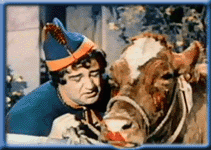  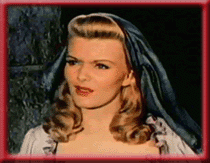 |
DOWNLOAD VIDEO CLIP
http://tesla.liketelevision.com/liketelevision/tuner.php?channel=11&format=movie&theme=guide
LINKS
EARLY CINEMA
Good selection of clips and trailers of early
cinema available at this site, eg Clip of Greta Garbo Screen Test, Babes
in Toyland (1934), The Jolson Story (1946), Niagara (1953), White Gorilla
(1947), Animal Crackers (1930), Becky Sharp , Bride of the Monster, Way
Out West, Seven Year Itch
http://www.sabucat.com/
Early Color Motion Picture Processes - Additive and Subtractive Color
Systems Explained
http://www.widescreenmuseum.com/oldcolor/additive-subtractive.htm
Motion Picture and Television Picture Reading Room - American Library
of Congress
http://www.loc.gov/rr/mopic/
